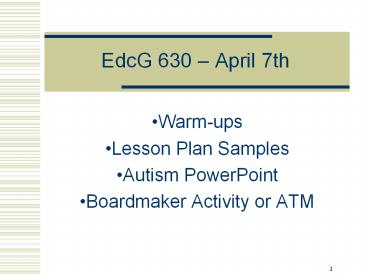Warm-ups - PowerPoint PPT Presentation
1 / 28
Title: Warm-ups
1
EdcG 630 April 7th
- Warm-ups
- Lesson Plan Samples
- Autism PowerPoint
- Boardmaker Activity or ATM
2
EdcG 630 April 7th
- Warm up 1
- Warm up 2
3
Teaching Students with Autism Spectrum Disorders
- Chapter 6
- April 7th, 2009
4
Focus QuestionsPart One
- What are the general areas of delays and concerns
that characterize individuals with autistic
spectrum disorders? - How do the characteristics of autism spectrum
disorders impact teaching and learning?
5
Autism Spectrum Disorders
- are complex, neurological disorders that affect
the functioning of the brain - can be present in a variety of combinations and
may accompany other disabilities
6
Autism Spectrum Disorders
Autistic Disorder
Aspergers Disorder
Retts Disorder
Childhood Disintegrative Disorder
Pervasive Developmental Disorder Not Otherwise
Specified
- Impairments in social behaviour
- Communication difficulties
- Stereotypic or unusual behaviours
7
Social Impairments
- Multiple nonverbal behaviours
- eye-to-eye gazes
- facial expressions
- body postures
- gestures
- Peer relationships
- Spontaneous seeking of others
- Social or emotional reciprocity
8
Communication Impairments
- Delay in language development
- Difficulty initiating or sustaining a
conversation - Repetitive or idiosyncratic language
- Lack of varied spontaneous imaginative play
9
Repetitive Patterns of Behaviour
- Preoccupation with patterns of interest
- Inflexible adherence to routines
- Repetitive motor mannerisms
- Preoccupation with parts of objects
10
Other Autism Spectrum Disorders
- Aspergers Disorder
- social impairments and unusual behaviours
- average or above cognitive abilities
- communication and anxiety are issues
- language development not significantly delayed
- Retts Disorder
- occurs only in females, very rare
- Childhood Disintegrative Disorder
- regression in multiple areas after normal
development - Pervasive Developmental Disorder Not Otherwise
Specified - does not meet diagnostic criteria for autism
11
General Characteristics of ASD
- Communication difficulties
- Social interaction difficulties
- Unusual behaviours
- Unusual patterns of attention
- Unusual sensory responses
- Anxiety
- Learning difficulties
12
Communication
- Nonverbal communication difficulties
- Expressive language delays
- Oral language differences
- Language use not for social purposes
- Echolalia speech
- Perseveration on a topic
- Restricted vocabulary
- Difficulty with conversations
- Comprehension difficulties
13
Social Interaction
- Establishing and maintaining relationships
- playing with others
- taking turns and sharing
- Theory of mind
- understanding other perspectives
- making sense of social behaviour
- making sense of feelings and emotions
- making sense of communication
14
Implications for InstructionIdeas and Examples
- Communication
- Social interaction
15
Implications for InstructionIdeas and Examples
- Communication
- Instruction based on assessment results
- Instruction should emphasize
- paying attention
- imitating
- comprehending words and instruction
- using language for social reasons
- developing functional communication
16
Implications for InstructionIdeas and Examples
- Social Interaction
- Social Skill Development
- Tolerating others in own space
- Imitating the actions/vocalizations of others
- Engaging in parallel activities
- Taking turns
- Using eye contact
- Explicitly teach theory of mind concepts
17
Unusual Behaviours
- Diagnostic criteria
- preoccupation with patterns of interest
- inflexible adherence to routines
- repetitive motor mannerisms
- preoccupation with parts of objects
- Unusual response to sensory stimuli
- Challenging aggressive destructive behaviours
- Behaviours are the tip of the iceberg. It is
essential to delve - below the surface to identify the message of the
behaviour.
18
Unusual Patterns of Attention
- Stimulus overselectivity
- Difficulty disengaging and shifting attention
- Short attention span
19
Sensory Characteristics
- Often hypersensitive or hyposensitive to
- tactile
- auditory
- visual and olfactory
- olfactory
- gustatory
- vestibular and proprioceptive
20
Anxiety Characteristics
- Difficulty regulating emotions
- Inability to express oneself clearly
- Sensory processing needs
- High need for predictability
- Difficulty understanding social situations
21
Implications for InstructionIdeas and Examples
- Unusual behaviours
- Attention
- Sensory responses
- Anxiety
22
Implications for InstructionIdeas and Examples
- Unusual or Challenging Behaviours
- Teaching students new skills and interests
- Understanding responses to sensory stimuli
- Preparing the student for planned changes
- Developing calming strategies
- Assisting the student to monitor level of arousal
or anxiety - Adapting the learning environment
23
Implications for InstructionIdeas and Examples
- Patterns of Attention
- Information and instructional activities should
be provided in a format that
- is clear and concise
- is consistent with comprehension level
- focuses their attention
- emphasizes the most relevant information
24
Implications for InstructionIdeas and Examples
- Sensory Responses
- Assess sensory responses.
- Be aware of different experiences of sensory
stimulation. - Use alerting strategies to help enhance students
when hyposensitive. - Implement strategies to calm students when
hypersensitive.
25
Implications for InstructionIdeas and Examples
- Anxiety
- Provide warnings about transitions and changes.
- Provide daily and weekly schedules.
- Use social scripts to encourage calming and teach
coping skills. - Provide facts about anxiety-arousing situations.
- Establish a calming area.
26
Learning Characteristics
- Uneven cognitive profile
- Deficits in attending to relevant cues
- Language impairments
- Difficulties with abstract reasoning
- Planning, organizing and problem solving
- Strong rote memory and visual spatial skills
27
Implications for InstructionIdeas and Examples
- Learning
- Instruction should be based on assessment results
and emphasize
- organization skills
- problem-solving skills
- visual cues and reminders
- concrete language
28
A is for Autism F is for Friend
Video Sample
Boardmaker






























![❤[PDF]⚡ Vocal Warm Ups & Exercises For Actors, Speakers & Voice Artists PowerPoint PPT Presentation](https://s3.amazonaws.com/images.powershow.com/10062235.th0.jpg?_=20240622025)
